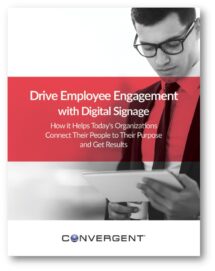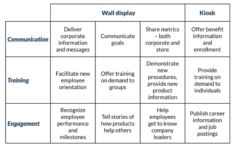
Chances are, you already have some guidelines that come to mind when designing creative content: stay away from red, ensure your content is engaging, know your audience, etcetera, etcetera. But what would the experts say are the non-negotiables when creating effective content specific to digital signage?
Is it the layout of the messages?
Possibly.
Is it the color scheme or clever wording?
Could be.
How about the eye catching branded content that really draws the viewer’s attention?
You’re getting there.
We sat down with one of our experts to discuss some of the secrets of the trade. Here’s the skinny, it is more involved than just using a special layout or clever wording. To create successful digital signage, here are 5 things to think about before booting up the screen.
1. Define your goals, scope and resources: What good is a message without a strategy? In our opinion, the strategy is the pinnacle of all digital signage projects. So where do you start?
Here are some questions to think through when kicking off your digital signage solution:
1. What are your overall business goals?
2. What are your goals specific to the Digital Signage as a Service (
) project?
3. Do these specific goals align with your overall business goals?
The answers to these questions are your backbone. As you begin to hammer out the scope of your project, always come back to these answers to stay on target.
Additionally, it is also important to understand the budget, resources, and timing it will take to execute on this job. For easy prioritization, determine the most important aspects of the project. Maybe your scope is key, but timing is not a huge issue. Modify your project so that you can execute to the scope you desire but flex a bit on the timing. As these key elements become defined, it is important they work together to make a realistic scope and deadline that will later back up to your project goals. This way, your digital signage project won’t become delayed or known as the “dreaded never-ending, budget-spiraling project from the depths of…” well, you see where we’re going with that one.
2. Define what success looks like: It is imperative to understand how this project will be successful. How can you determine success if you haven’t defined what success means to you? It’s simple.
Here are some questions to think through.
1. What’s your end goal?
2. How can this be
?
3. What measurements would be attainable but challenging?
4. Do these measurements line back up with your
?
There are different ideas of what being successful actually means, so it is crucial to determine and align here with the stakeholders. Without the definition of success, it’s difficult to get you where you want to be.
3. Brainstorm with key stakeholders
Gaining “buy-in” from your stakeholders is imperative as you kick off this – potentially – new initiative. With their support, alignment, and * ahem * money, you want to be sure you can prove the value in your digital signage solution. As you modify and measure, you can make optimizations to increase your solution’s effectiveness.
4. Ensure all your messages align to your brand values, the project and the environment
To tie it all together, we believe it is crucial to ensure that all of your messages align. The media you create must have synergy with your brand messaging. Take a look at the environment you will be placing your signage, are you duplicating any promotions or sending any conflicting information? Additionally, think through your other strategies. Are you missing any key information your company would like to push? Only once you are confident on the content messaging can you begin to develop the motion graphics.
5. Ensure your brand has been set
How could you expect to align your digital signage to your brand if your brand doesn’t have a clear voice, look, and feel? In the eyes of the experts, this is an absolute must. Knowing and defining the character of your brand is critical in helping you create effective digital signage. When your brand is clearly outlined, and your digital signage follows suit, your brand will transcend in the digital and live spaces. Without this component, you and your digital signage will become obsolete, potentially creating a negative effect.
So how do these tips help lead you and your business to success? Well, with aligned messages, full support, and consistent branding you know you are on the right track.
In the eyes of the experts, your overall strategy can be a tough cookie to crack. When you spend time on
, you can
. Based on benchmarks, you can make adjustments to your signage which will only increase your message’s effectiveness. Now that you’ve got some tools in your belt, go and dream big. Using these expert tips, we hope your c-suite is beyond impressed.
The post
appeared first on
.











